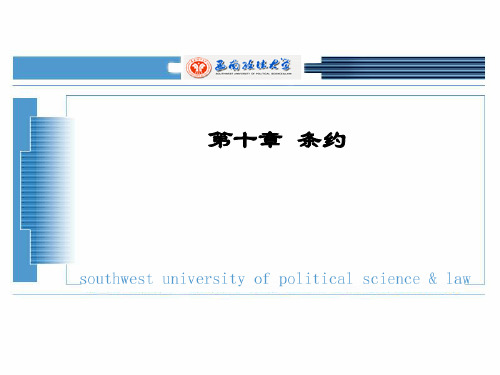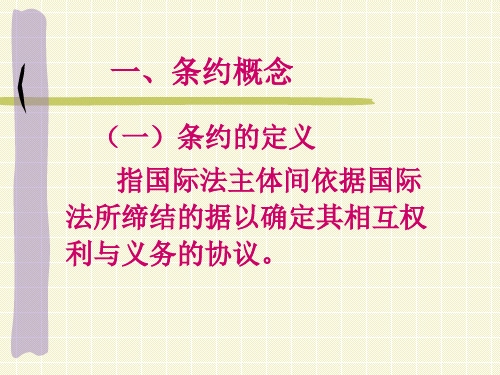第十章条约法
第十章条约法

甲乙丙三国定有贸易条约。后甲乙两国又达成新 的贸易条约,其中许多规定与三国前述条约有冲 突。新条约中规定,旧约被新约取代。甲乙两国 均为《维也纳条约法公约》的缔约国。根据条约 法,下列错误的是
A.旧约尚未失效
B.新约不能完全取代旧约
C.新约须经丙国承认方能生效
D.丙国与甲乙两国适用旧约
第四节 条约的解释
(二)条约的特征:
1、条约的主体必须是国际法主体;(英伊石油公司案) 2、条约必须以国际法为准: (1)内容合法 (2)程序合法 3、缔约双方必须有一致的意思表示; 4、条约内容是为缔约国创设国际法上的权利和义务;
(君子协定) 5、条约主要采书面形式。(格陵兰岛法律地位案)
二、条约的名称 :
全权证书
兹委派××(职衔)××(姓名)为全权代 表同××国的全权代表谈判并签订中华人民共和 国和××国××(条约名称)条约。
中华人民共和国国务院总理 (签字)
中华人民共和国外交部长 (签字)(副署)
二零××年×月×日于北京
注:1、国家元首、政府首脑、外交部长无须出
示全权证书。
2、一国驻外使节和驻在国的谈判无须出示全权 证书。
A、如无不同意的表示,视为修正后条约的当事国 ; B、其和不受修正条约拘束的原当事方的关系,适用未
修正条约。
第六节 条约的无效、终止和暂停施行 一、条约的无效 1、 违反国内法关于缔约权的规定 2、 错误(隆端寺案) 3、 诈欺 4、 贿赂 5、 强迫(慕尼黑协定) 6、 与强行法规则冲突
假设甲乙两国自愿通过谈判、签署和批准的程序, 缔结了一项条约。该条约的内容包括:出于两国 的共同利益,甲国将本国的领土提供给乙国的军 事力量使用,用来攻击丙国国内的某个种族。根 据国际法,下列错误的是
第十章: 条约法

程 序 外交部或 者国务院 报请 有关部门 会同外交 部
2. 接受或核准:同样程序
3.没有必须批准的义务 4.正式认可:国际组织
(四)交换或交存批准书
deposit of instruments of ratification )
(exchange or
条约的登记与公布
国际联盟规约》 条规定, 《国际联盟规约》第18条规定,所有国际条约要 条规定 在秘书处登记,秘书处从速予以公布, 在秘书处登记,秘书处从速予以公布,未经登记 的条约无强制力。 的条约无强制力。 联合国宪章》 《联合国宪章》第102条规定联合国的任何会员 条规定联合国的任何会员 国应将缔结的一切条约及国际协定尽快在秘书处 登记,并由秘书处公布 没有登记的条约或协定,不 并由秘书处公布。 登记 并由秘书处公布。没有登记的条约或协定 不 得在联合国任何机关援引。 得在联合国任何机关援引。 但根据<维也纳条约法公约 的规定, 维也纳条约法公约>的规定 但根据 维也纳条约法公约 的规定,登记不是条 约生效的条件。 约生效的条件。
加入与生效
现代条约法的理论和实践认为,加入与生效是两个不 现代条约法的理论和实践认为 加入与生效是两个不 同性质的问题;条约生效与否不影响非签字国的加入 条约生效与否不影响非签字国的加入, 同性质的问题 条约生效与否不影响非签字国的加入 而只涉及到对加入国的效果.加入已生效的条约对加 而只涉及到对加入国的效果 加入已生效的条约对加 入国立即产生拘束力;加入未生效的条约则只表示加 入国立即产生拘束力 加入未生效的条约则只表示加 入国同意受条约拘束,在该条约未生效之前并不对加 入国同意受条约拘束 在该条约未生效之前并不对加 入国产生拘束力. 入国产生拘束力 加入的程序一般是由加入国以书面形式通知条约保 存方(国家或国际组织 由保存方转告其他缔约国,条 国家或国际组织),由保存方转告其他缔约国 存方 国家或国际组织 由保存方转告其他缔约国 条 约何时对加入国生效,由各该条约本身加以规定 由各该条约本身加以规定. 约何时对加入国生效 由各该条约本身加以规定
国际法第十章

(五)保留的程序
保留、明示接受保留及反对保留,都必须以
书面形式提出并致送缔约国及有权成为条约 当事国的其他国家。 五、条约的保管和登记 条约的保管机关由谈判国在条约中或以其他 方式指定。
p9
第三节条约的生效和效力
一、条约的生效和有效期 (一)条约的生效 条约的效是指在法律成立的条约对各当事国发生 拘束的法律效果。 (二)条约的有效期 条约的有效期一般都在条约中铭文规定,可分为无 限期和有限期两种。 二、条约的效力 (一)条约对缔约国的效力 1.条约必须遵守 2.条约的执行
p3
五、条约的历史发展
六、条约法及其编篆 条约法是关于条约的缔结、效力和解释等问
题的原则、规则和制度的总称,其作用在于 调整和规范国际法主体间的条约关系。
p4
第二节条约的缔结
一、缔约能力和缔约权
缔约能力是指在国际法上可以合法缔结条约
的能力或资格;缔约权是指有有权缔结条约 的机构的权限。 在国际法上,只有国家和其他国际法主体才 有缔约能力,缔约权由国家和其他国际法主 体的内部法律决定。 二、缔约程序 (一)谈判 谈判是有关各方为了就条约的内容达成一致 协议而进行的交涉,是缔结条约的第一步。
p6
三、条约的加入
加入是指没有在条约上签字的国家表示同意
接受条约拘束的一种正式国际法律行为。 四、条约的保留 (一)保留的概念 保留是指“一国与签署、批准、接受、核准 加入条约时所作之片面声明,不论措辞或名 称为何,其目的在于摒除或更改条约中若干 规定对该国适用之法律效果。 (二)保留的提出
p 15
2.条约当事国嗣后共同同意该条约终止或暂停施行 3. 一般国际法上条约的终止或暂停施行 (1)体育嗣后履行不能 (2)条约长期不适用 (3)嗣后出现与条约不相容的强行法规则 (4)条约履行完毕 (5)情势根本变更 (6)违约 (7)单方面解约或退出 (8)断绝外交或领事关系 (9)战争 (二)条约终止和暂停施行的后果
第十章条约法lawoftreaties

甲国倡议并一直参与某多边国际公约的制订, 甲国总统与其他各国代表一道签署了该公约的 最后文本。根据该公约的规定,只有在2/3以 上签字国经其国内程序予以批准并向公约保存 国交存批准书后,该公约才生效。但甲国议会 经过辩论,拒绝批准该公约。根据国际法的有 关规则,下列哪一项判断是正确的?
第十章 条约法
(law of treaties)
第一节 概
一、定义
述
❒ 两个或两个以上国际法主体 以国际法为准确立相互间权利义务的书面 协议
二、条约的名称 三、条约的结构和文字 四、条约法编纂
主体:国际法主体
个人、法人:N0
concession ≠ treaty Anglo-lranian Oil Co. Case (United Kingdom v. Iran)
See Case Concerning Questions of Interpretation and Application of the 1971 Montreal Convention arising from the Aerial Incident at Lockerbie (Libyan v. UK and USA)
特
征
标准:国际法
国内法支配:NO
君子协定
(gentlemen's agreement)
内容:权利和义务
政治宣言
形式:书面形式
口头条约:Y
称‘条约’者,谓国家间所缔结而以国际 法为准之国际书面协定,不论其载于一项 单独文书或两项以上相互有关之文书内, 亦不论其特定名称为何。
——ART.2,1969GCLT
(二)条约的适用(application of treaties) (三)条约对第三国(third states)的效力
国际法第十章条约法

遇有下列情形之一,一国承受条约拘束之 同意,以批准表示之: (甲)条约规定以批准方式表示同意;
(乙)另经确定谈判国协议需要批准;
(丙)该国代表已对条约作须经批准之签署;
或
(丁)该国对条约作须经批准之签署之意思可 见诸其代表所奉之全权证书,或已于谈判时有此 表示。
在开放性多边条约签署之后,未在条约上签 署的国家表示同意受条约约束的一种法律行为。 遇有下列情形之一,一国承受条约拘束之同 意以加入表示之: (甲)条约规定该国得以加入方式表示此种同 意; (乙)另经确定谈判国协议该国得以加入方式 表示此种同意; (丙)全体当事国嗣后协议该国得以加入方式 表示此种同意。
之任何权利、义务或法律情势。
( 3 )一国废止或退出多边条约时,在该国与条约每一 其他当事国之关系上适用上述效果。
2.条约暂停施行的后果
(1)解除停止施行期间在彼此关系上履行条约之义务。
(2)不影响条约确定的当事国间法律关系。
(3)当事国应避免足以阻挠条约恢复施行之行为。
参考书
李浩培:《条约法概论》(第二版),法律出版社, 2003年。
特定限制
事实或情势错误 文字错误
不平等条约
强行法无溯及力 与强行法冲突 第53条:溯及力
1.条约确定失效的条约无效。条约无效者,其规定无 法律效力。 2.依此种条约而实施之行为: (1)每一当事国可要求任何其他当事国在彼此关系 上尽可能恢复未实施此项行为前原应存在之状况; ( 2 )在援引条约失效之理由前以善意实施之行为并 不仅因条约失效而成为不合法。 (3)前两项不适用于欺诈、贿赂或强迫引起条约无 效的效果。 3. 上列各项规则在援引同意无效的国家与多边条约 的其他当事国之关系上适用
3. 修正条约之协定对已为条约当事国而未成为该协定当
第十章条约法分解

一、条约的签订和保留
二、条约的效力
本章基本内容
一、 概述
二、 条约的缔结
三、条约的生效和效力
四、条约的解释和修订
五、条约的无效、终止和暂停实施
第一节
概述
一、条约的概念与特征: (一)条约(treaty)的概念:
是国际法主体间依据国际法为确定其相互间的权利和义
符合原则(相对原则)
2、保留的法律后果:
1)保留国和接受保留国之间: 在保留范围内,改变保留所涉条约规定; 2)保留国和反对保留国之间:
A、反对方可主张条约在两国之间无效;
B、反对方也可主张在保留范围之内,不适用于 双方。
4、撤回保留及撤回对保留的反对:
随时撤回,无须经对方国家的同意,但应及时通 知有关国家,收到通知之日生效。
二、条约的名称 : 1、广义的条约
2、狭义的条约
条约 treaty 公约 Convention 协定 agreement 议定书 protocol
最正式 国际会议通过 某一方面具体问题 辅助性法律文件
宪章charter、规约、 成立国际组织的组织条约 盟约 宣言declaration或声 会议后公开发表的文件 明
3.签署形式: (根据国家主权原则)
A.双边条约:轮换制; B.多边条约:以国名的字母顺序依次签字。 1、批准适用情形:175页 (《维也纳条约法公约》第14条) 国家元首 2、批准机关 (国内法规定) 立法机关
注:批准是国家主权行为,国家没有必须批准的义务。
国际法(条约)

第二节 条约的缔结
一、缔约能力与缔约权 二、缔约程序 1.谈判:全权证书与约文的议定 2.签署:草签、暂签与正式签署 3.批准(接受、核准与正式认可) 4.批准书的交换与交存 三、条约的加入
第二节 条约的缔结
四、条约的保留 保留的概念和意义。 保留只涉及保留国与其他缔约国之间的关 系。 五、条约的保管和登记
第三节 条约的生效和效力
一、条约的生效、暂时适用和有效期 二、条约的效力 (一)条约对缔约国的效力 (二)条约的适用 (三)条约对第三方的效力 基本原则是:条约对第三方既无益也无损。
第四节 条约的解释
一、条约的解释的概念和种类 二、条约解释的机关(主体) 三、条约解释的规则 1.主观学派、客观学派与目的学派与条约 法公约第31条的规定 2.补充资料的使用和作用 3.用多种语言缔结的条约的解释问题
第一节 概说
一、条约的定义 (一)定义 条约是国际法主体间依据国际法确立其相互 权利和义务而缔结的书面协议。 这是根据1969年5月23日《维也纳条约法公 约》和1986年3月21日 《关于国家和国际组织 日 间或国际组织间条约法的维也纳公约》两个重 要条约的规定得出的定义。
第一节 概说
(二)特征 1、条约的主体只能是当代国际法所承认的 国际法主体。 2、必须以国际法为准。 3、双方合意。 4、规定缔约各方间在某一问题或某些问题 上的权利和义务关系。 5、通常是书面形式的协议。
第五节 条约的修订
一、条约的修订的概念和种类 修订分为全体当事国参加的修正和部分当 事国参加的修改。 二、条约的修订原则和程序 原则是以当事国之间的协定进行。
第六节 条约的无效、终止和暂 停施行
一、条约的无效 二、条约的终止和暂停施行 三、条约终止和暂停施行的后果
第十章 条约法

• (4)凡不属于以上情况的,除条约另 有规定外,如果保留经另一缔约国接受, 就该另一缔约国而言,保留国即成为该 条约的当事国;如果保留经另一缔约国 反对,条约在反对国与保留国之间并不 因此而不发生效力,但反对国明确表示 相反意思者不在此限;一国表示同意受 条约约束而附有保留的行为,只要至少 有另一缔约国已经接受该保留,就成为 有效。
• 而1986年的《维也纳条约法公 约》,其全称为《关于国家和国际 组织间或国际组织相互间条约法的 维也纳公约》 • 适用于国家与国际组织之间或国际 组织相互之间缔结的条约。
(二)条约的特征
• 1、条约是国际法主体间签订的协 议。 • 条约的双方或各方都必须是国际法 主体,只要一方不是国际法主体, 就不构成条约。
2、国家无必须批准的义务
• 一般而言,重要的条约特别是一般 性多边条约都需要批准。 • 条约是否需要批准由缔约国自主决 定,国家没有批准条约的义务。 • 如1919年美国总统威尔逊亲自签 署了《凡尔赛和约》,但美国参议 院(须2/3多数票批准)不予批准, 这使美国不能成为国际联盟的成员 国。
3、批准的变通
五、条约的保管、登记及公布
• 《国际联盟盟约》中,将条约的登记作 为国际联盟成员国的义务,并且还规定, 条约或国际协定未经登记以前不发生效 力。这样,将登记作为条约生效的一个 必经程序。 • 在《联合国宪章》的第102条中规定, 联合国任何会员国所缔结的一切条约以 及国际协定应尽速在秘书处登记,并由 秘书处公布之;当事国对于未登记的条 约或国际协定,不得向联合国任何机关 援引之。
第十章 条约
一、条约的概念与特征
• (一)条约的定义 • 1、条约的含义 • 条约是指两个或两个以上的国际法 主体依据国际法缔结的关于其相互 权利和义务关系或它们的行为规则 的书面协议。
第十章条约法(TheLawofTreaties)

2、签署(signature)
是缔结程序中的关键环节。 是表示缔约国同意承受条约的拘束。 草签(initial)和待核准的签署 (signature ad referendum)一般不使条 约具有拘束力, 条约签署采轮换制或字母顺依次签字。
3、批准、接受、赞同
(ratification,acceptance,approval)
包括条约的修正与修改。 修正(amendment)指全体当事 国对条约进行更改。 修改(modification)指在若干 当事国之间对多边条约的更改。
六、条约的终止与无效
(一)条约的终止(termination)
指条约到期或由于某种事实或原因而失去了效 力,有以下原因:
条约到期; 条约解除条件的成立 ; 条约被代替 ; 退出 ; 缔约各方同意终止条约; 单方终止条约。
B如果先后两个条约的缔约方不完全相同, 有两种适用办法:
一是同为先后两个条约的当事方间,先 约也仅仅在其规定与后约相符的范围内 适用,即后约优先于先约
二是在为两个条约当事方与仅为其中一 个条约的当事方之间,依两方都是当事 方的条约为准。
(五)条约的执行
方式: 1、纳入(直接适用):不须另经过国内 立法程序而直接纳入国内法 2、转化(间接适用):须经国内立法程 序转化为国内法 3、混合转化:即采用转化和纳入的方式
批准指缔约国的有权机关对其全 权代表所签署的条约的确认并同 意接受条约的约束。
国家也可采用接受、赞同方式同 意承受条约的拘束。
4、互换和交存批准书
双边条约的缔约方互相交换各 自国家权力机关批准该条约的 证明文件。
多边条约一般将批准书交存保 存条约正本的某缔约国政府或 国际组织。
5、条约的加入(accession)
国际法课件 第十章 条约法

1949年,联合国国际法委员会决定把条约法的编纂作为其最优先的工作。到1966年,国际法委员会完成 条约法公约草案。1969年,维也纳外交会议通过《维也纳条约法公约》。该公约不仅将习惯条约法成文化, 而且适当发展了条约法,被认为是成功的国际法编纂和良好的条约法法典。嗣后,维也纳外交会议在1978年 和1986年还分别通过《关于国家在条约方面的继承的维也纳公约》和《关于国家和国际组织间或国际组织相 互间条约法的维也纳公约》。后者在实质规定方面与1969年《维也纳条约法公约》基本一致。
第一节 条约的概念与条约法编纂
三、条约法编纂
国际法委员会目前正在对“条约的暂时适用”专题进行研究,已经完成“对条约的保留”、“武装冲突 对条约的影响”、“条约随时间演变”和“与条约解释相关的嗣后协定和嗣后惯例”专题的研究。2011年, 委员会通过《对条约的保留实践指南》和关于武装冲突对条约的影响的18条条款草案。
(一)谈判
谈判是有关各方为了就条约的内容达成一致协议而进行的交涉,是缔结条约的第一步。谈判一般由有缔 约权的国家机关进行。国家元首是国家在外交关系上的最高代表,因此,条约可以由他亲自谈判。但通常是 由政府首脑、外交部长、驻外使节或特派全权代表进行谈判。国家元首、政府首脑和外交部长由于其对外代 表国家的特殊地位,在谈判时一般无须出示全权证书。一国驻外使节同驻在国政府谈判条约也无须出示全权 证书。但在实践中,上述人员参加谈判也有提交全权证书的事例。
条约法

条约法第一节概述一、条约的定义和特征条约是国家等国际法主体之间缔结的并受国际法支配的国际协议。
它有如下主要特征:(一)条约是国际法主体之间缔结的协议(二)条约是受国际法支配的协议(三)条约是具有法律拘束力的协议(四)条约通常是书面形式的协议第二节条约的缔结一、缔约能力和缔约权缔约能力,是指缔约方以自己的名义缔结条约、独立享受条约权利、承担条约义务以及承担违约责任的能力,这种能力是依国际法确定的。
缔约权,即缔约的代表权,是指具有缔约能力的国际法主全的有关机关拥有的代表该主全缔结条约的权力。
二、条约的缔结程序条约的缔结程序,是指缔结条约一般要遵循的步骤和履行的手续。
实践中,缔约程序可因条约的重要程度以及谈判方的意愿而有所不同,但一般须经以下程序:(一)约文的议定(二)约文的认证(三)表示同意受条约拘束表示同意受条约拘束的方式:1. 签署2. 批准3. 加入4. 接受第三节条约的效力一、条约的生效二、条约必须遵守的原则条约必须遵守原则,是指对于在主权平等、充分表达自己意愿基础上的各项有效条约,各当事方必须按照条约的规定,善意地解释条约,诚实地履行条约义务。
任何当事方都不得以任何借口违反条约的规定,不得从事违反条约目的和宗旨的任何活动,除情势发生根本变迁等特殊情况外,不得任意废弃条约规定的义务。
三、条约对第三方的效力对于一个条约来说,第三方指不是这个条约当事方的国家、国际组织或其它国际法主体。
在条约法上,条约对第三方的效力问题是指一个条约是否为第三方创设权利或义务的问题。
严格地说,条约是当事方之间的协议,仅对当事方产生效力,而不对第三方产生有利或不利的影响,即“条约对第三方既无损,也无益”。
1969 年《条约法公约》第34 条规定:条约未经第三国同意,对第三国既不创设义务,亦不创设权利。
但是在条约的实践中,却存在着条约为第三方创设义务或创设权利的情形,从而引起对第三方的效力问题。
(一)条约为第三方创设义务(二)条约为第三方创设权利四、条约的适用(一)条约的适用范围就条约适用的时间范围来说,条约一般都自其对缔约方生效之日起开始适用于该缔约方,此时的缔约方即成为该条约的当事方。
国际公法第十章条约法

国家是国际法的基本主体,也是缔约的基本主体,它具有完全的缔约能力。
政府间国际组织具有缔约能力,缔约能力的依据是成立该组织的约章。
民族解放组织在一定条件下和一定范围内具有缔约能力。
第二节 条约的缔结
缔约权(power to conclude treaties)是指国家和其他国际法主体内部某个机关或个人代表国家行使缔结条约的权限。由国家或其他国际法主体的内部法律决定。
互换批准书 (instrument of ratificaton)
有些条约除需要批准外,还必须交换批准书或正式确认书。互换批准书,是指缔约双方互相交换各自国家权力机关或国际组织批准该条约的证明文件。
多边条约因签字国多,无法交换批准书,一般采用交存制度,即把批准书或正式确认书交给条约规定的国家或国际组织保存。
03
全权证书(full powers),指一国主管当局所颁发,指派一人或数人代表该国谈判,议定或认证条约约文,表示该国同意承受条约拘束,或完成有关条约的任何其他行为的文件。
04
第二节 条约的缔结
《维也纳条约法公约》规定不需要出具全权证书的人员:
A
国家元首、政府首脑、外交部长;
B
使馆馆长为了议定派遣国与接受国之间的条约约文的谈判,也无须提出“全权证书”;
第二节 条约的缔结
八、条约的适用 1、条约适用的时间范围: 一般条约自其生效之日起开始适用。 条约不溯及既往(non-retroactivity)。 2、条约适用的空间范围: 效力应及于当事国的全部领土。 3、
条约的冲突
联合国宪章义务优先 其他情况具体对待
第三节 条约的无效和终止
一、条约的无效 条约的无效(invalidity of treaty),是指条约缔结时因不符合国际法所规定的条约成立的实质要件而自始无法律效力的情况。 1、违反国内法关于缔约权限的规定。 2、错误(error)。 3、诈欺(fraud) 4、贿赂(corruption) 5、强迫(coercion) 6、违反一般国际法强制规范(强行法)。
第九章条约法

第九章条约法第⼗章条约法第⼀节概说⼀、条约的概念(treaty)国际法主体之间,主要是国家间依据国际法所缔结的据以确定其相互权利与义务的国际书⾯协定。
特征:1、是国际法主体之间缔结的协议(主要是国家之间,其他主体也有缔约权:⽐如联邦成员国、国际组织、罗马教廷)2、是受国际法⽀配的协议(缔结、修改、解释遵循国际法。
国家与私⼈签订的协议受国内法调整,政府之间的采购协议受国内法或国际私法调整)3、是具有法律拘束⼒的协议4、通常是书⾯形式的协议(并不是说⼝头的条约⽆效,只是很少⽤)⼆、条约的名称1、公约(convention):通常是多个国家举⾏国际会议缔结的多边条约《海洋》2、条约(treaty):狭义的条约,是最为正式的⼀种,适⽤于国际法主体之间⼀些重⼤的政治、经济、法律等问题。
(和平条约、边界条约、军事同盟条约)3、宪章(constitution、charter)、规约、盟约:国际组织的基本⽂件、章程4、协定(agreement):最常见适⽤最⼴泛。
针对某⼀具体问题(国际航空协定)5、议定书(protocol):主条约的附属⽂件,补充、解释。
《补充蒙特利尔公约的议定书》,可以与主条约同时⽣效,也可以在主条约运⾏⼀段时期后产⽣。
6、⽂件、总⽂件、最后⽂件:⽂件——在国际会议上通过的⼀般国际法规则或者解决⼀般国际法问题的多边条约,通常称为“总⽂件”。
“最后⽂件”通常不构成条约,只是正式的叙述或总括⼀个国际会议的程序,并列举通过的条约、公约。
(⽐如维也纳会议最后⽂件中就总结了会议达成的17项条约、宣⾔和规章),签署最后⽂件不等于签署了⽂件中列举的条约、公约。
7、宣⾔(declaration):有时是条约性质的⽂件,有时仅仅是⼀个国际⽂件,并⾮条约。
是否是条约取决于当事国的意思表⽰和缔约程序。
联合国⼤会通过的宣⾔,⼀般不是条约,只是对会员国的⼀种号召和建议。
8、联合声明、联合公报(joint communique):两个以上的国际法主体就同⼀事项发表的共同声明。
中国人民大学国际法各章节重点

中国人民大学国际法各章节重点中国人民大学国际法各章节重点第一章导论名词解释.国际法的渊源2.国际习惯.一般法律原则.国际法的编纂5.国际法主体6.一元论7.二元论论述题1.论述国际法与国内法的理论及实践。
2.结合实践,分析我国国内法与国际法的实践。
第二章国际法的基本原则名词解释1.国际法基本原则\2.国际强行法3.主权4.内政简答题1.国际法基本原则的特征是什么?2.国际法基本原则与国际强行法有何关系?论述题1.论述和平共处五项原则在国际法基本原则中的地位。
2.如何理解国家主权的责任观念。
第三章国际法上的国家名词解释1.邦联2.被保护国3.永久中立国4.自卫权5.属地优越权6.不承认原则7.国家继承8.法律上的承认简答题1.国家的基本权利。
2.法律承认的效果。
3.单一国与联邦国家的区别。
4.条约继承的国际法规则。
论述题1.试述国家豁免制度。
2.结合实践,说明中国是一个单一的国际法主体,对于中国的承认与继承问题应适用的国际法制度。
第四章国际法上的个人名词解释1.国籍2.国民待遇3.最惠国待遇4.外交保护5.引渡6.庇护7.双重犯罪简答题1.我国国籍法的基本原则。
2.外国人待遇的一般原则及其适用。
3.外交保护的行使。
4.引渡制度。
论述题1.试述我国引渡法制度。
2.如何认识我国不承认双重国籍的原则。
第五章国际人权法名词解释1.人权2.国际人权法3.人民自决权4.人权的国际保护5.难民6.克减权简答题1.简述人权问题的历史发展。
2.简述国际人权的基本内容。
3.简述国际人权保护的实施制度。
4.核心国际人权条约有哪些?论述题1.试说明人权国际保护与国家主权和不干涉内政的关系。
2.试述中国在人权问题上的立场。
3.分析国际人权保护实施制度的发展趋势。
第六章国家领土名词解释1.国家领土2.国际河流3.先占4.时效5.割让7.国家边界8.国际地役9.占有原则简答题1.对领土主权有哪些限制?2.划界的程序和原则有哪些?3.南极法律制度。
- 1、下载文档前请自行甄别文档内容的完整性,平台不提供额外的编辑、内容补充、找答案等附加服务。
- 2、"仅部分预览"的文档,不可在线预览部分如存在完整性等问题,可反馈申请退款(可完整预览的文档不适用该条件!)。
- 3、如文档侵犯您的权益,请联系客服反馈,我们会尽快为您处理(人工客服工作时间:9:00-18:30)。
第十章条约法Chapter8 The Law of Treaties•Teaching aims and requirements:•教学目的与要求:•This Chapter will help the students understand the definitions ,classification of the treaty. The students will be also required to get the idea of the procedure of the conclusion of treaty. They should understand interpretation, amendment and modification of treaties. The relation between the parties to treaties and the third parties is of great importance, so it should be required by our Students.The Vienna Convention on The Law of Treaties created the new rule andregulations to govern the relation of the States concerning the fairs of the treaty, which constitutes the main contents of the contemporary law of treaties, and which should be what the students must keep in their minds.•本章的教学将帮助学生理解条约的定义和分类。
本章还将要求其了解条约的缔结程序以及条约的解释和修改等等。
缔约国与第三国的关系问题也极为重要,应该为学生所了解。
维也纳条约法公约在规范和调整国家之间的条约关系方面创设了一系列新的规则和原则,构成了当代条约法的核心内容,这也应该为学生牢记。
•Key and difficult points:•教学要点与难点:•●The Vienna Convention on The Law of Treaties.•●Conclusion of treaties;•●Treaties and third parties.•● Treaty interpretation.•●Termination of treaties.•The introductory questions: (先行问题)• 1 What is pacta sunt servanda?• 2 What is law-making treaty?• 3 Please expound the procedure of the conclusion of a treaty.第一节概述•一、条约和条约法的概念•(一)条约的概念•目前已生效的一部条约法公约是1969年《条约法公约》,它是确立国家间条约法关系的公约。
按该公约规定,条约是国家间以国际法为准缔结的国际书面协定。
不论是一项单独文书还是载于两个以上的文书内。
• a treaty as “an international agreement concluded between States in written form and governed by international law…”.•由此可见条约的特征有:•(1)条约是国际法主体间的协议;an international agreement•(2)条约为缔约方创设权利与义务;intention to create rights and obligations •(3)条约以国际法为准;governed by international law•(4)条约主要以书面形式存在。
in written form•(二)条约法的概念P282•条约法是调整国际法主体,主要是国家之间条约关系的原则和规则。
•(三)条约的作用•1、条约是国际法的主要渊源之一。
•2、条约是国际间进行交往的重要法律形式。
•3、条约对缔约国具有拘束力。
(四)条约法编纂•二、条约的种类和名称P285•(一)条约的种类classification of treaties•(二)条约的名称names of treaties第二节条约的缔结•一、缔约能力capacity to make treaties•凡是国际法主体都有缔约资格,但由谁行使缔约权,则取决于各国国内法规定。
•❒缔约能力是指在国际法上可以合法缔结条约的能力或资格(1969 年《维也纳条约法公约》第六条)❒缔约权是指有权缔结条约的机构的权限。
至于一国有哪些机关代表国家行使该项权利,由其国内法,特别是宪法加以规定•二、缔约程序P287-293•1、谈判与议定条约约文negotiation and adoption of a treaty text(二)签署(signature)1. 正式签署❒条约的正式签署遇有下列情形之一,一国承受条约拘束之同意,以该国代表之签署表示之:(甲)条约规定签署有此效果;(乙)另经确定谈判国协议签署有此效果;或(丙)该国使签署有此效果之意思可见诸其代表所奉全权证书或已于谈判时有些表示。
2. 草签:认证(authentication )(三)批准1. 条约的批准遇有下列情形之一,一国承受条约拘束之同意,以批准表示之:(甲)条约规定以批准方式表示同意;(乙)另经确定谈判国协议需要批准;(丙)该国代表已对条约作须经批准之签署;或(丁)该国对条约作须经批准之签署之意思可见诸其代表所奉之全权证书,或已于谈判时有此表示。
2. 接受或核准:同样程序3.没有必须批准的义务(四)交换或交存批准书(exchange or deposit of instruments of ratification ) •三、条约的加入accession•未在条约上签字的国家决定参加该条约并受其拘束的一种正式国际法律行为。
遇有下列情形之一,一国承受条约拘束之同意以加入表示之:(甲)条约规定该国得以加入方式表示此种同意;(乙)另经确定谈判国协议该国得以加入方式表示此种同意;(丙)全体当事国嗣后协议该国得以加入方式表示此种同意。
•条约有开放性条约、封闭性条约、有限开放性条约之分。
•四、条约的保留•不愿接受或排除条约中某些规定,不受其约束。
•(一)保留成立的条件•传统国际法:一致同意规则,关注条约内容的完整性。
•现代国际法:只要不一致反对,关注条约参加者数目的广泛性。
•(二)保留的限制•1、保留为条约所禁止•2、条约规定仅准许特定的保留,而有关的保留不在其内•3、保留与条约的目的与宗旨不合•(三)保留的接受和反对P294 acceptance and objection to reservations•(四)保留的法律效果legal effects of reservations•(五)反对保留的法律效果legal effects of objections to reservations•五、条约登记和公布registration and publication of treaties•条约生效后交联合国秘书处登记和公布•(一)目的•防止国家间缔结“秘密协议”,使民主国家的人们在这类条约公开披露时能拒绝接受。
•(二)不登记的后果•不影响条约对缔约国的效力。
•今后不得在联合国机构中援引该协定,特别是国际法院的审判中。
联合国的这种做法不同于国际联盟。
后者规定,未经在国联登记的条约,不发生法律效力。
第三节条约的遵守、适用和解释•一、条约必须遵守原则pacta sunt servanda•这是一项古老的国际法原则。
在条约有效期间,各缔约国应善意地、严格地履行条约规定的义务,它对履行国际条约奠定了基础。
•二、条约的适用application of treaties•(一)时间范围•一般生效之日开始适用,不具有追溯力。
•(二)空间范围territorial application•缔约国的全部领土。
•国家是作为一个整体由于缔约而成为条约当事国的。
•三、条约在国内的执行•属于国内法范围,各国通过宪法或者其他法律规定,以保证一切生效条约的执行。
•各国实践提供的国内法执行条约的方式:•1、通过宪法规定执行条约•2、国家通过专门规定和颁布的法律规定执行条约•四、条约对第三国的效力•条约只适用于缔约各国之间,未经第三国同意,不对该国产生义务或权利。
这是一项公认的国际法原则。
•条约非经第三国同意,不该为该国创设权利义务。
•创设义务,对第三国发生义务,必须是该条约当事国有在条约中为缔约国创设义务之表示;而第三国应以书面形式明示接受此项义务。
•创设权利,第三国接受条约为其创设之权利,并不要求以书面明示接受,而只要求表示同意;而且该第三国无相反之表示,应推定其同意。
•五、条约的解释P302 interpretation of treaties•对条约的合意、内容和适用条件所作的正确说明。
•(一)解释主体•(二)规则•1、一般规则general rule•条约应依其用语按其上下文并参照条约的目的和宗旨所具有的通常意义,善意予以解释。
有文字解释、系统解释和功能解释等类型。
•2、补充性解释方法•条约的谈判记录、历次草案和会议记录等可以作为一种重要的补充性资料。
•3、一种以上文字条约的解释P306第四节条约的修正与修改•因为国际情势和各种情况的变化引起条约的修正和修改•一、条约的修正•全体当事国对条约进行更改•如果条约当事国而非修正协定当事国,则修正条约协定对其无拘束力。
•修正协议生效后成为条约当事国,未有不同意表示,应为修正后当事国。
而对不受修正条约协定拘束的条约当事国为未修正条约的当事国。
•二、条约的修改•两个以上当事国彼此间对多边条约的更改•必须是条约内规定有作此修改可能,或有关修改不为条约所禁止的,同时不能影响其他缔约国享有条约上规定的权利或履行其义务,以及不涉及到有效实现整个条约的目的和宗旨的。
第五节条约的无效、终止和停止施行•一、条约的无效P310-314•1、违反国内法关于缔约权的规定provisions of internal law regarding competence to conclude treaties•2、错误error•3、诈欺fraud 和贿赂corruption•4、强迫coercion•5、与一般国际法强制规律相抵触conflict with a peremptory norm of general international law•6、条约无效和后果与程序consequences and procedures of invalidity•二、条约的终止和停止施行P315-318•1、依条约的规定或经当事国同意而终止或退出条约termination or withdrawal under the terms of a treaty or by consent of the parties •2、条约因违约而终止或停止施行termination or suspension for breach•3、因发生意外而不可能履行supervening impossibility of performance•4、情势根本变迁fundamental change of circumstances•伯利劳夫人诉瑞士案•1981年5月29日,瑞士公民玛兰·伯利劳夫人由于参加了一次未经官方批准的示威游行而被洛桑市警察当局处以罚款。
